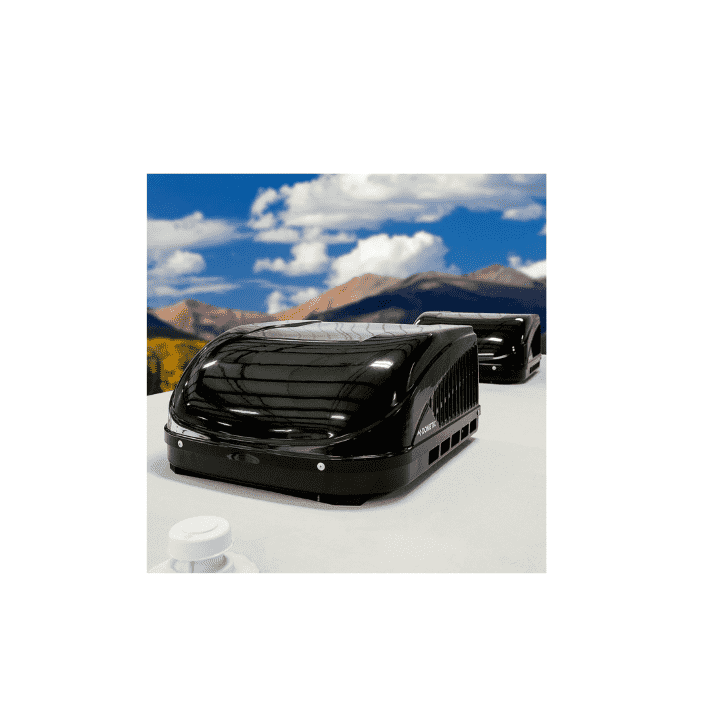RV Air Conditioner Maintenance Tips for Long-Lasting Cooling
Recreational Vehicles (RVs) are your home on wheels, offering comfort, convenience, and adventure all in one. A crucial part of this experience is the RV air conditioner, ensuring that you stay cool and comfortable no matter where you travel. However, like all mechanical systems, RV air conditioners need proper maintenance to continue performing effectively over time. Failing to maintain your unit can lead to reduced cooling, inefficiencies, and even costly repairs. In this article, we will walk through essential maintenance tips that can help extend the life of your RV air conditioner and ensure consistent cooling on your journeys.
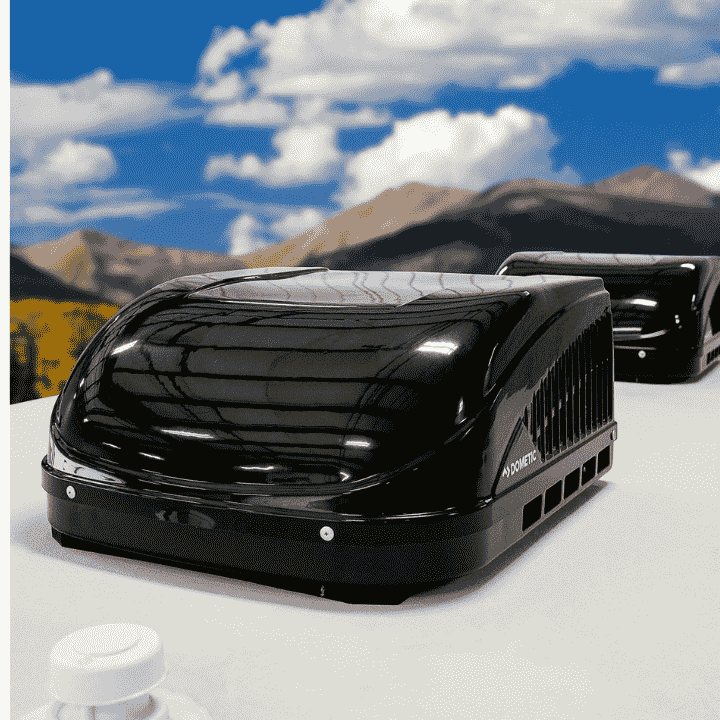
1. Understanding Your RV Air Conditioner
Before diving into maintenance, it’s important to understand how an RV air conditioner works. Most RV ACs are rooftop units that pull in outside air, cool it using a refrigerant cycle, and circulate it inside. The components include an evaporator coil, condenser coil, compressor, fan, and thermostat. Understanding the basic parts will give you a better sense of what needs regular attention and care.
2. Clean or Replace the Air Filter Regularly
One of the simplest yet most effective ways to maintain your RV air conditioner is by regularly cleaning or replacing the air filter. The air filter is designed to capture dust, pollen, and other particles, preventing them from clogging up your unit. A dirty filter restricts airflow, making the air conditioner work harder and less efficiently, potentially causing damage.
- How often should you clean or replace the filter? Ideally, inspect the filter every two weeks when in heavy use, and clean or replace it at least once a month. If you travel through particularly dusty areas, you may need to do it more often.
- How to clean it: If it’s a reusable filter, remove it and rinse it with warm water. Let it dry completely before placing it back into the unit. For disposable filters, simply replace them with a new one.
3. Inspect the Evaporator and Condenser Coils
Both the evaporator and condenser coils are critical for heat exchange and cooling efficiency. Over time, dirt and debris can accumulate on the coils, reducing their ability to transfer heat. This buildup forces your AC to work harder and use more energy to cool the same amount of air, which can eventually lead to mechanical failures.
- How to clean coils: Turn off the AC, remove the outer cover of the unit, and use a soft brush or a vacuum with a brush attachment to gently clean the coils. You can also use a coil cleaner, which is available at most hardware stores. Make sure to rinse off any residue after cleaning.
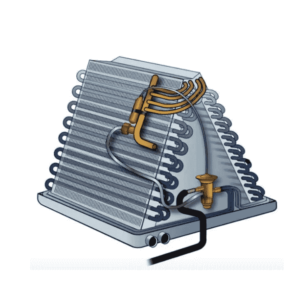
4. Check the Thermostat Accuracy
Your RV air conditioner relies on the thermostat to regulate the temperature inside the vehicle. If the thermostat isn’t functioning properly, it may not cool effectively or may cycle on and off too frequently, leading to uneven cooling or higher energy usage.
- Test the thermostat: Set the temperature and see if the AC cools to the correct level. If the cooling doesn’t match the thermostat settings, you may need to recalibrate or replace it. In some cases, simply replacing the thermostat’s batteries can resolve issues.
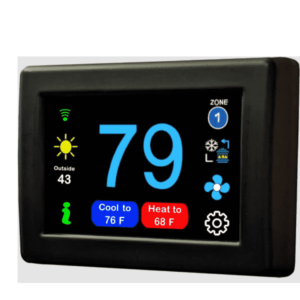
5. Lubricate the Fan Motor
The fan motor is an essential component that circulates cool air throughout the RV. Without proper lubrication, the motor’s bearings can wear out, leading to inefficient operation or even mechanical failure. Regularly lubricating the fan motor can extend its life and ensure smoother operation.
- How to lubricate: Consult your AC’s user manual to determine where the lubrication points are. Use a lightweight oil or a motor-specific lubricant, and apply it to the bearings according to the manufacturer’s recommendations. Be sure not to over-lubricate, as this can lead to build-up and additional problems.
6. Inspect and Tighten Electrical Connections
The constant movement of an RV can cause electrical connections within the air conditioner to loosen over time. Loose connections can lead to short circuits or reduced power efficiency, both of which can harm your AC system.
- How to inspect: Turn off the AC and power supply before inspecting the electrical connections. Carefully examine the wires and connectors for signs of wear, corrosion, or loose fittings. Use a screwdriver to tighten any loose connections, but if you notice frayed wires or significant corrosion, it’s best to have a professional handle the repairs.
7. Clear Debris from the Exterior Unit
Because most RV air conditioners are mounted on the roof, they are constantly exposed to outdoor elements like leaves, dirt, and debris. If this debris accumulates around the exterior unit, it can restrict airflow and reduce cooling performance. Periodically clearing the area around the unit will help it function at its best.
- What to check for: Look for leaves, branches, and other debris that may be blocking airflow. Make sure the AC’s vents are not obstructed, as this can also reduce efficiency. It’s a good idea to clean the area around your AC unit after parking your RV under trees or during long periods of travel.
8. Inspect and Maintain the Seals
Over time, the seals around your RV air conditioner can deteriorate due to exposure to sunlight, moisture, and temperature changes. If the seals wear out, air can leak into or out of your RV, causing the AC to work harder to maintain the desired temperature. This not only reduces cooling efficiency but can also strain your AC’s components.
- How to check seals: Look for any visible cracks or gaps around the AC unit. You can use a sealant or weatherproof caulk to repair small cracks, but for larger issues, it’s best to replace the seals altogether.
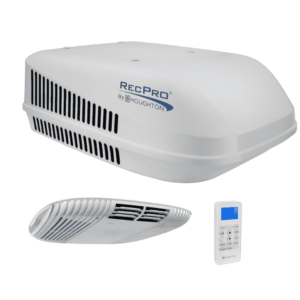
9. Check the Condensate Drain Line
The condensate drain line is responsible for removing the excess moisture that your AC pulls from the air. If this drain line gets clogged, water can back up into the system, causing damage or leading to mold growth inside the RV.
- How to clear the drain line: Turn off the AC, locate the drain line, and use a wet/dry vacuum or a pipe cleaner to clear out any blockages. Make sure the line is free of debris, so water can flow out easily. rv air conditioner
10. Schedule Professional Inspections
Even with regular maintenance, it’s a good idea to have a professional inspect your RV air conditioner at least once a year, especially before a long trip. A professional technician can catch potential problems early, check refrigerant levels, and ensure the unit is functioning properly.
- Why it’s important: Regular professional check-ups can help identify issues that you might not notice during routine maintenance. Addressing these early can save you from costly repairs or breakdowns while on the road. rv air conditioner
11. Use an AC Cover When Not in Use
When your RV is parked or in storage for an extended period, it’s important to cover your AC unit. This will protect it from debris, dust, and other environmental factors that can build up while the unit is not in use.
- How to use: Purchase a breathable, weatherproof AC cover designed specifically for RV units. Make sure it fits snugly over the unit and secure it with straps or bungee cords. Avoid using a non-breathable plastic cover, as it can trap moisture and lead to rust or mildew.
12. Use Energy-Efficient Settings
To minimize the strain on your air conditioner, try using energy-efficient settings when possible. This not only extends the life of your unit but also helps conserve power, which is important when you’re running on limited energy sources in an RV.
- Temperature settings: Set your thermostat to a moderate temperature to reduce wear on the unit. Using fans to circulate air inside the RV can also help reduce the burden on the AC.
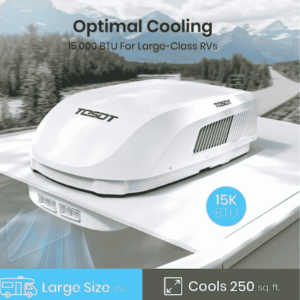
13. Optimize Ventilation for Better Airflow
While your RV air conditioner plays a key role in keeping the interior cool, it’s also essential to optimize airflow within the RV itself. Poor ventilation can cause uneven cooling and force your AC to work harder, which can lead to premature wear and tear.
- Use roof vents: Many RVs come equipped with roof vents or fans. Open these vents to allow hot air to escape and improve air circulation. This helps the AC distribute cool air more effectively, especially in the upper sections of the RV.
- Strategic fan placement: Use portable fans to assist in moving air around the RV. Place fans near windows or doors to pull in cooler outside air during the evening or early morning hours. This reduces the workload on your AC during peak heat times.
14. Reduce Heat Inside the RV
One of the best ways to extend the life of your RV air conditioner is to reduce the amount of heat it needs to cool. Simple steps to minimize heat inside the RV can make a big difference in AC performance and longevity.
- Close blinds and shades: Direct sunlight can significantly increase the temperature inside your RV, making your AC work harder. Close curtains, blinds, or install reflective window covers to block sunlight during the hottest parts of the day.
- Cook outdoors when possible: Cooking inside generates heat and humidity, which your AC will need to counterbalance. Opt for outdoor grilling or using an electric skillet outside to reduce the strain on the cooling system. rv air conditioner
- Turn off electronics: Many electronic devices generate heat while in use. Unplug or power off non-essential devices, such as TVs, laptops, and gaming consoles, to prevent additional heat build-up.
15. Monitor and Maintain Refrigerant Levels
The refrigerant is the lifeblood of any air conditioning system, including your RV’s AC unit. Over time, refrigerant levels can decrease due to small leaks, reducing the unit’s ability to cool efficiently. Low refrigerant levels cause the compressor to work harder, potentially leading to overheating and breakdowns.
- How to monitor refrigerant levels: Unfortunately, checking refrigerant levels is not something that most RV owners can do themselves. If you notice that your AC isn’t cooling as effectively, produces warm air, or cycles on and off frequently, it might be a sign of low refrigerant. Contact a professional to inspect and refill refrigerant if necessary. rv air conditioner
- Detecting refrigerant leaks: If your refrigerant levels are consistently low, you may have a leak in the system. Look for oily residue on the AC unit’s fittings, or listen for hissing sounds. Professional inspection and repair are necessary to fix leaks properly.
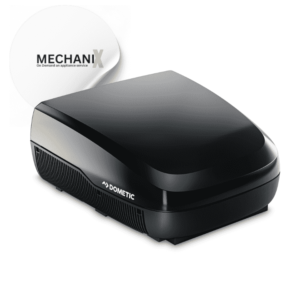
16. Be Mindful of Humidity Levels
Humidity plays a significant role in how comfortable your RV feels. High humidity levels not only make the interior feel warmer but also force your AC unit to work harder, as it needs to remove both heat and moisture from the air.
- Use a dehumidifier: If you frequently travel through areas with high humidity, consider investing in a portable dehumidifier for your RV. Reducing moisture levels will take some of the workload off your AC and make the interior feel cooler without lowering the temperature drastically. rv air conditioner
- Ventilate during showers: Bathrooms are a major source of humidity in an RV. After taking a shower, make sure to open the bathroom vent or window and use an exhaust fan to let the moist air escape quickly.
17. Limit the Number of People Inside
The more people inside your RV, the more body heat is generated, making it harder for the AC to cool the space efficiently. While it’s not always practical to limit the number of people inside the RV, especially on family trips, it’s a factor to consider during very hot days.
- What to do: If you have a large group of people, encourage spending time outside during the hottest parts of the day. This will reduce the heat load inside the RV and give your AC a break. rv air conditioner
18. Upgrade to a Programmable Thermostat
One of the most efficient upgrades you can make to your RV’s air conditioning system is installing a programmable thermostat. These devices allow you to set specific temperature schedules, ensuring that your AC only runs when it’s needed, which reduces energy consumption and wear.
- How it helps: A programmable thermostat can be set to turn off or reduce cooling during times when you’re not inside the RV, such as when you’re exploring the area or enjoying outdoor activities. You can also set it to cool more efficiently at night when outside temperatures are lower, reducing strain on the system. rv air conditioner
- Installation: Most RVs can accommodate a programmable thermostat with relative ease, though you may need to consult your AC’s manual or hire a technician for installation.
19. Keep an Eye on Fan Speed
Your RV air conditioner likely has multiple fan speed settings. Adjusting the fan speed based on conditions can enhance cooling efficiency and help preserve the life of the unit.
- When to use high speed: On especially hot days, using the high-speed fan setting will circulate air more quickly and evenly throughout the RV. However, prolonged use at high speed can wear down the fan motor over time. rv air conditioner
- When to use low speed: In moderate temperatures or at night, switch to a lower fan speed. This will still provide adequate cooling without putting unnecessary strain on the fan motor.
20. Check the Condenser Fins
The condenser fins located on the rooftop unit are responsible for dissipating heat. These fins are very delicate and can easily become bent, which restricts airflow and reduces the efficiency of the AC.
- How to maintain condenser fins: Inspect the fins regularly for signs of bending or damage. You can use a fin comb, which is designed to straighten bent fins. Be gentle when using the comb to avoid breaking the fins altogether.
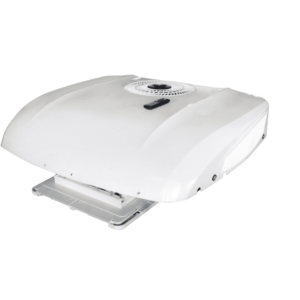
21. Consider an AC Soft Start System
If you frequently travel to campgrounds with limited electrical hookups or use a generator to power your RV, consider installing an AC soft start system. This device reduces the initial surge of power required to start the air conditioner, making it easier to run the unit on lower power sources.
- Benefits: An AC soft start system reduces strain on your electrical system and helps extend the life of both your RV’s AC and your generator. It can also make it possible to run your AC unit more efficiently when using solar power or a limited electrical hookup at campsites.
22. Use a Surge Protector
RVs are often subject to power fluctuations due to the variability of campground electrical systems. A sudden surge of electricity can damage your air conditioner’s delicate components, potentially leading to costly repairs.
- What to do: Invest in a quality surge protector for your RV. This will safeguard your air conditioner and other electronic systems from unexpected power spikes, ensuring longer-lasting performance. rv air conditioner
Conclusion
Maintaining your RV air conditioner not only ensures a comfortable living environment but also saves you from unexpected breakdowns and costly repairs. By following these extended maintenance tips—such as optimizing airflow, managing refrigerant levels, reducing humidity, and using protective equipment like surge protectors—you can significantly extend the lifespan of your AC unit. Implementing a regular maintenance routine will keep your RV cool and comfortable, allowing you to enjoy your road trips without worrying about an overheated interior. Keep these tips in mind, and your rv air conditioner will provide long-lasting cooling for all your adventures ahead.
rv air conditioner
